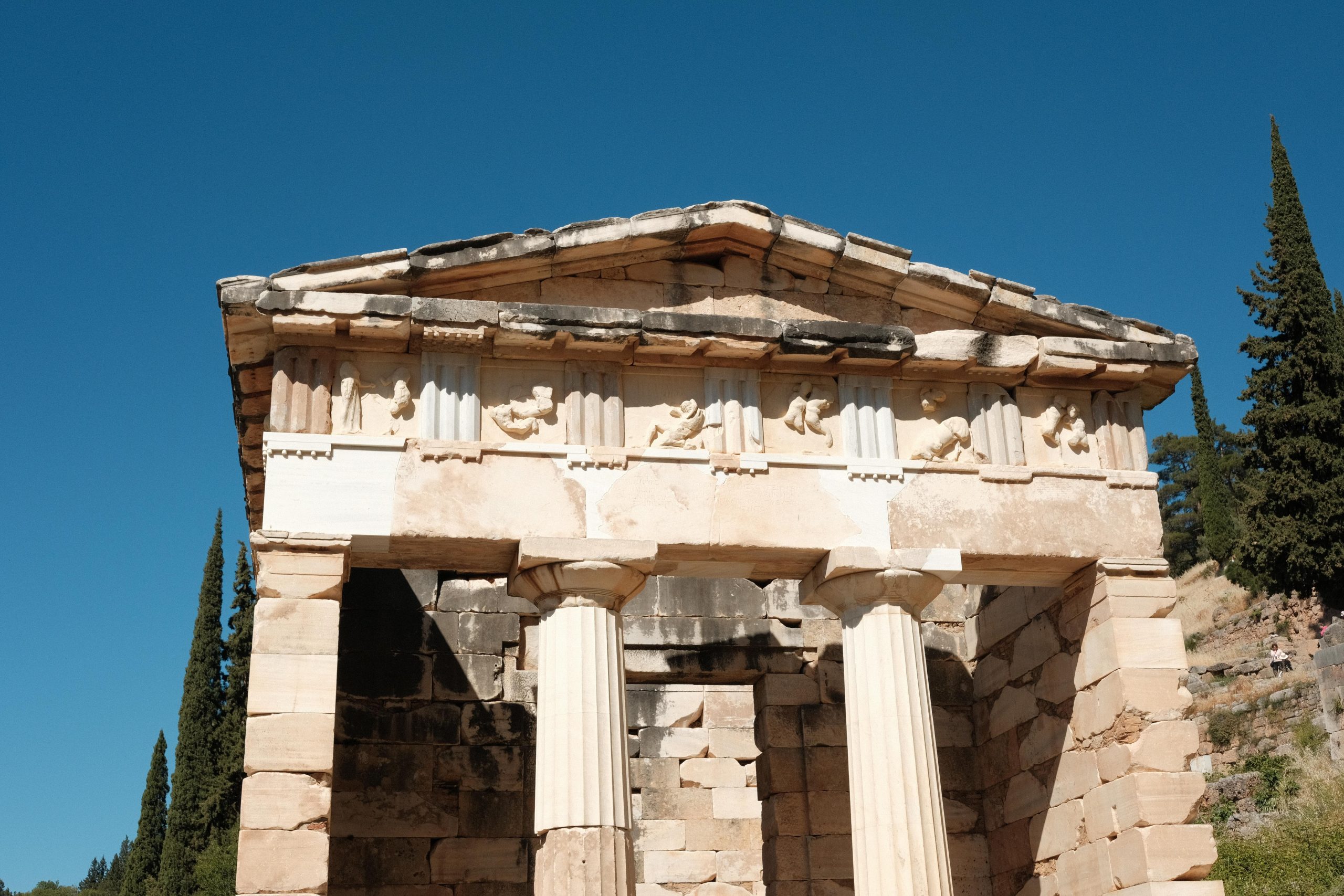Good morning readers!
We have just visited our fourth UNESCO world heritage site, and possibly the one I have been most excited for yet – The Sanctuary of Apollo at Delphi. I grew up reading and watching stories based on Greek mythology, and as I got older I started cultivating an interest in the real historical events as well. When I was younger I visited Ephesus in Turkey, one of the most important and well preserved cities in ancient Greece which once housed the Temple of Artemis (one of the seven wonders of the ancient world) and still houses the Library of Celcus. At uni I took a classics paper on the rise and fall of Ancient Greece and I only wish I took it earlier. Knowing the historical context of a site completely reforms your experience of it- its magical how an intangible thing such as knowledge can turn something from a pile of rocks into a portal to the past. It allows you to imagine what it would have been like to stand on these charged stone walkways and breathe same the holy air as the Oracle.
This post is what came out of my own rabbit hole of research and nerdy fascination with the magical place that is Delphi.
But p.s. if you’re ever in a pinch, you can always sneakily follow around an English tour group or two 😉

The Sanctuary of Apollo
The Sanctuary of Apollo at Delphi is one of the most historically significant Pan-Hellenic sanctuaries that still exist in Greece. The complex sits on the southern slopes of Mount Parnassus, in an otherwise incredibly remote part of the country. You don’t just stumble upon the Temple of Apollo, you have to ascend to it as pilgrims and prospectors to the oracle once did. It’s not quite at the summit, yet it still feels above the world. In the morning light, it’s easy to imagine the Gods’ presence here.
The ruins are more a suggestion than a structure these days. The ground lies strewn with stones— fragments of column, broken pedestals, and bits of foundation all jumbled together, a jigsaw poured out of the box. The only bits that remain are some of the edge pieces— a few columns and the marble seats of the theatre and stadium.
The place feels still, despite the tourists. Pine and dust and the sound of cicadas drift through the thin air. The view rolls over sweeping olive groves, planted centuries ago to pump the olive-oily blood around Ancient Greece


The Legend
According the Greek legend, the site of Delphi was important before the temple was even built. It was known as the belly button of the world, which was found by Zeus. He had sent two eagles from Mount Olympus, flying in opposite directions. According to the story, they crossed paths right above Delphi. Zeus demarked this located with a sacred stone called the omphalos (meaning “navel”).
Originally, Delphi belonged to the earth goddess, Gaia, and was guarded by a monsterous serpent called Pytho. Apollo, son of Zeus and God of prophecy, the sun, the arts and music, truth and reason, healing and disease, slayed Pytho to claim Delphi as his own. There he established the Delphic Oracle, where the priestess Pythia (named in relation to the serpent) would serve as his mouthpeice. He built the first temple there from laurel branches, which were known to be his sacred tree. However, the fact remained that Apollo had killed a sacred creature, a child of Gaia. He had to atone for the slaying, and in some accounts, he was said to have been banished from Olympus for several years. In memory of this victory over Pytho, panhellenic festivals were held at Delphi in Apollo’s honour, including the Phythian games. These included musical and athletic competitions every four years, which drew crowds from all over Ancient Greece.
When I visited the site of the Sanctuary of Apollo, I was surprised to find a lot of artifacts relating to the God Dionysus, God of wine, theatre, fertility, festivity, insanity and ritual madness (a bit of an off the rails type of dude). I discovered that in memory of his exile from Olympos, Apollo was said to vacate Delphi for the three months of winter, and Dionysus took his place. During these months, prophesies were suspended, and instead estatic rites were performed in Dionysus’ honour. We’re not sure for certain why the Pythia had three months per year of holiday leave, but historians believe the dual worship of Apollo and Dionysus was necessary to balance the religious world. Where Apollo was known for promoting order, reason and prophecy, Dionysis worked at the opposite end of the religious scale, revelling in esctasy, chaos and rebirth. While there were no large temples of Dionysus at the Sanctuary of Apollo, he is depicted in statues, objects and inscriptions relating to Dionysian rituals.


The Omphalos of Delphi in the museum (left) and the simplified version marking the location onsite (right)
The Temples
After Apollo built his first temple, ancient sources mention a “Temple of the Bees” supposedly built thereafter. To be honest, I’ve got no idea what this means. One guide said it was built by bees???? But wikipedia seems to think it was built from beeswax. Either way, it probably didn’t exist, but if it did it would have been a smaller symbolic shrine. The first known stone temple dates back to the 6th century BCE, made from limestone in the Doric style. It was believed to have been destoryed by a fire- I don’t really understand how something built of stone can be destroyed by fire but anyway. The (partially) existing temple was completed around 330 BCE on the same site, this time from marble.
The sanctuary today is centred around the Temple of Apollo, where the prophecies were delivered, but also includes various other buildings to serve the community events. A winding paved path called the Sacred Way leads up the the temple, lined with statues and monuments. Multiple treasuries, including the Treasury of the Athenians and the Treasury of the Siphnians, were built by variious city-states to house offerings to Apollo and show off their wealth. The site also includes a theatre for Dyonysus’s performances, a stadium for the Pythian games, a Stoa for pilgrims to gather and conduct business, and the “Tholos of Delphi”- a circular building with an unknown function.



The Oracle
The first Pythia, Oracle to Apollo, was likely a local, young, virgin woman from a humble background. This was important because purity was of the utmost importance in Ancient Greek religion. A peasant or shepardess would likely have been chosen because she was uncorrupted by luxury or politics, closer to nautre, and genuinely devout. The Pythia would have been selected in a process of being “called” by Apollo, possibly by having a vision, seizure or entering a trance. Once chosen, her status would have significantly elevated, as she lived in the sancturay and was cared for by the Delphic priests. At first, the Pythia was required to be a young virgin, but after one Pythia was abducted or assulted, the rules changed so that only older women could serve, though they still wore the symbolic virginal robes.
While your mental picture of an oracle might have visions of the future, the Pythia delt mostly in descision-making, where to locate a new colony, when to attack an enemy, how to lift a curse, whom to choose as leader, what offering to make to which god. No kingdom was going to take the chance of making a critical descision without her consultation. Her influence, therefore, was incredibly powerful, making the sanctuary of Delphi the most rich and famous in the Hellenic world.

The Prophecies
When a visitor arrived at Delphi and ascended the Sacred Way to ask a question to the Oracle, they must first make an appropriate offering and then sacrifice a goat. We can tell from the impressive treasuries that were continually built that this process was quite lucritive for Delphi. They must have had a lot of goats on hand. The visitor would then enter the inner sanctum of the temple of Apollo. We know quite a bit about just how impressive the inside of this temple was, thanks to archaeoological artifacts, inscriptions and voitive offerings found onsite, as well as ancient writers like Pauanias and Herodotus. The temple contained the omphalos stone, the sacred fire which burned continuously in honour of Apollo, statues of Gods including Apollo, his twin Artemus and mother Leto, and possibly also Dionysus. Archaeologists also found an incredible stash of rich offerings like gold, silver, weapons, and figures of bronze, gold, marble and ivory. They also found over 6,000 inscriptions at Delphi, including the mottos “Know theyself” and “Nothing in excess” incribed at the entrance, which directed prospectors of the oracle to know what they wish to ask and not be greedy about it. Incriptions also included plenty of hymns and musical stanzas, since Apollo was the God of music.
According to the accepted account of the Oracle, the Pythia would drink from the Kassotis spring which flowed through the temple, to purify herself before prophesising. Authors Plutarch and Strabo (1st century CE) tell us that the Pythia would sit on a bronze tripod atop a chasm in the ground. Sweet-smelling vapours rose from beneath, said to be from the serpent Pytho. The oracle would inhale these vapours and fall into a trance. She might writhe around and foam at the mouth, Apollo speaking through her in crypic verse. Priests would listen and interpret her message for the inquisitor.
While this prophecy-inducing serpent vapour sounds rather mythical, In the 1990s, geologists found there might be a scientific basis to it. They discovered that the temple of Delphi lies over the intersection of two fault lines, which could explain the fissure over which the Pythia sat. It is posisble that ethylene gas rose from within, a sweet-smelling vapour known to cause euphoria and hallucinations in low doses.
Anyone could approach the oracle, not just kings or people in power. However, those propehcies are the ones that endured time the best and we know the most about today. In the 6th century BCE, Croesus of Lydia was said to have asked the Pythia whether he should attack the Persian Empire. She responded “If you cross the Halys River, you will destroy a great empire.” Pleased, croesus crossed the river to attack the Persian Empire, and in doing so, destroyed his own. According to Plato’s ‘Apology’ Chaerephon, close friend of the famous philosopher Socrates, visited the oracel to ask “Is anyone wiser than Socrates?”. The Pythia responded, “No one is wiser than Socrates”, thereby dubbing him the wisest person in the world. This launched Socrates’ lifelong philosophical pursuit to uncover the true meaning of wisdom, and his influential idea that wisdom is knowing what you don’t know (recognising your own ignorance).

The Roman Period
The Oracle of Delphi was so widely known that even the Romans of the 2nd cent. BCE to the 2nd cent. CE prospected the Pythia and strengthened the Pythian games. Nevertheless, during the Roman rule, the sactuary began to decline in prestigure. The main reason was that the Pythia would no longer be as essential for Hellenistic political developments, since these decisions were taken into the hands of the Roman senate. As a result, Delphi suffered financially, and fell to neglect, was eventually stripped of its treasures for the benefit of Rome.
Some Roman empires tried in vain to halt the decline of Delphi by taking care of its monuments. We know from a large and pompous iscription that Domitian repaired the temple of Apollo. Hadrian, a great admirer of Greek culture, revived the ancient religious pracitises and restured the remaining monuments around the late 2nd century BCE. But by this point, the sanctuary was already well past its glory days.
In the 4th century CE, under emporers such as Theodosius I, non-Christian temples pratises were increasingly banned, including the Temple of Apollo. Pagan sacrifices, rituals and oracles were forbidden by imperial law. It’s likely that the Temple of Apollo was closed as a result of this, and was either destroyed or fell to natural causes.

So that’s the story behind the stones. Knowing the history transformed my visit from a scenic stroll into a storybook—and I hope this helps it come alive for you too.
Signing off,
Milly x


